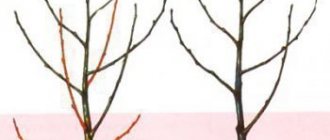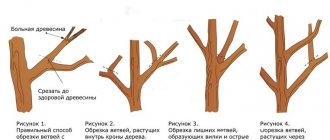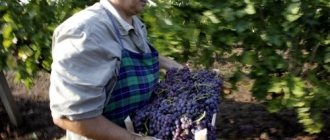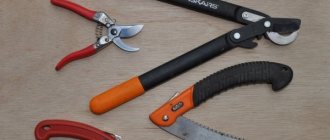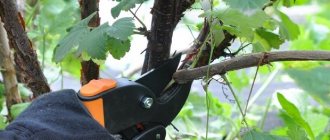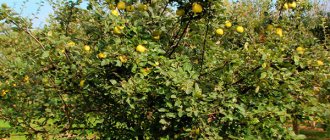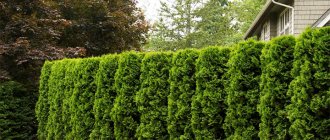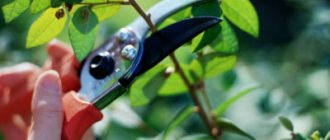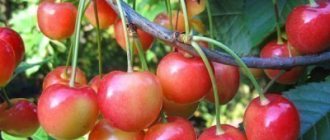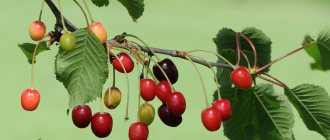When to prune cherries
Do not prune the tree too often, give it time to recover and gain nutrients. Timing and specifics of the work:
- Spring. The optimal time is mid-March - early April, before the active movement of juices and swelling of the buds. Indications: overgrown crown. 2 tiers are created - 7-9 skeletal branches are left on the first, 2-3 branches are left on the second. The tree is shortened to a height of 3-3.5 m. Damaged, frozen branches are removed.
- Summer. The right time is after flowering, before fruiting begins. Indications: new horizontal shoots are needed. Young, improperly growing shoots are shortened. For non-woody parts, pinching is recommended - pinching the tops. If necessary, repeat the procedure after harvesting.
- Winter. The time of the event is February, when the air temperature is +7 degrees. Anti-aging pruning is recommended. Indications: reduced yield, small fruits. Cut off excess, broken branches, shorten shoots that are too long.
- Autumn. Start the procedure after the leaves fall. Try to finish the work before the end of September. Indications: damaged, broken, extra shoots. Remove broken, weak shoots. If necessary, shorten annual shoots by 1/3. Thin out the tree and remove branches growing at irregular angles.
How to trim cherries
Common errors and their fixes
Pruning cherry trees is very important for the proper development of the tree and increasing the yield. Further formation of the tree largely depends on the accuracy of the procedure. Sometimes novice gardeners make some mistakes when removing cherry branches:
- Removal of young shoots in favor of old branches. Young shoots develop faster, so it is best to cut off one mature branch rather than cutting off new branches.
- Pruning young seedlings for autumn. One-year-old cherries that are not yet fully mature should be formed in spring or summer. A young seedling pruned in the autumn may not survive the winter cold.
- Treatment of sections with solvent-containing paints. To protect cuts, only harmless substances are used. According to the advice of experienced gardeners, garden var is considered the safest and most effective.
- Novice gardeners prune cherries in the fall when frost sets in. Branches should be shortened for the winter at the beginning of the autumn period, so that the cuts have time to last before the cold weather.
- Trimming with blunt objects. Shortening branches with a non-sharp knife can disrupt the structure of the tree, which will lead to drying out of the branch. Also, poor-quality pruning contributes to the penetration of pathogenic microorganisms into the cut areas. All procedures must be performed with a sharp, clean knife or pruning shears.
Unlike cherries, sweet cherries are demanding in terms of crown formation. Removing tree branches has many features. Knowing when and how to prune cherries correctly, you can achieve a rich harvest with high taste.
Types of pruning
Begin pruning the tree the first year after planting. Form a trunk, skeleton, crown. Formation of the crown of the cherry tree, pruning of skeletal branches and trunk are carried out in the spring. Leave thinning the bush until the fall. Prune plants over 5 years old at any time of the year.
Features of different types of pruning:
- Formative – from the first to the sixth year after planting. Particularly important for a one-year-old bush. The formation of cherries is carried out in early March, April, after the snow melts or before the buds swell. Needed to create a shape and ensure good crown density. Excess shoots affected by pests and frost are cut off.
- Maintenance or regulating - spring or autumn pruning of cherries, carried out annually. Needed to maintain the shape of the crown. Excess shoots are removed. The sooner you remove them, the easier it will be for the bush.
- Sanitary (hygienic) – once every 5 years or more often. The time for pruning is spring or autumn, after fruiting. Carried out to reduce the risk of infectious diseases. Diseased branches are cut and burned.
- Anti-aging – once every 5 years or as needed. Time: spring, early autumn, after harvest. Needed to adjust the crown, eliminate excess, dry, broken, diseased branches. They work with old, non-bearing and neglected bushes.
- In order to limit upward growth - as necessary. Pruning time is autumn or spring. A cup-like or sparsely tiered crown is formed (the “Australian Bush” or “Spanish Bush” method). Strongly raised branches are shortened. Due to this, the growth of external branches is activated.
- During the fruiting period. The procedure is carried out in the summer to form the crown and remove broken shoots.
Cherry pruning systems
Pruning in spring
Cherry buds awaken very early, so initial pruning is possible as early as early March. It is not recommended to touch seedlings whose height is less than 70 cm, as they are still too weak.
Scheme of phased pruning of cherries
Spring pruning is carried out as follows:
- shorten the central trunk after planting;
- in the second year the lower tier of branches is formed;
- work with the second tier occurs in the third year of the tree’s life.
When the tree begins to bear fruit, thinning pruning is carried out in the spring. It is also important to promptly remove damaged and frozen branches.
Cherry - pruning and shaping the bush, video
How to trim cherries
If the tree is tall, use a stepladder. To cover “wounds”, prepare garden varnish or oil paint using drying oil. This will protect the tree from infections. Disinfect the instruments in advance - heat them over a fire, wipe with a cloth moistened with alcohol or a solution of copper sulfate (5%). The work is carried out with the help of:
- pruning shears, garden shears - for thin branches;
- lopper - for branches with a diameter of up to 2.7 cm in the depth of the crown;
- garden saw - for anti-aging pruning, for removing old thick branches;
- garden knife - to create an even cut.
Tools for pruning cherries
Peculiarities of pruning depend on the type of cherries - tree-like or bush-like. Rules of procedure for beginners:
- Cut large branches from the bottom first. This will help avoid damaging most of the living bark.
- Cut down 3-5 year old branches, loosening the pressure of the hacksaw towards the end.
- Pruning with pruning shears is carried out obliquely.
- Until 5 years of age, cherries need to reduce branches to 50 cm. Shoots that do not form a crown should be shortened to 30 cm.
- The distance between skeletal branches is from 30 cm.
Pruning depending on crown type
In tree cherries, bouquet branches appear a year after the formation of buds. These branches bring the main harvest. Pruning is carried out to thin out the crown or shorten the growth. The height of the shoots should not exceed 2.5 m. Stages of annual pruning of cherry trees:
- Pinch off the tops. Do not touch shoots up to 20 cm.
- Remove forks. Make cuts at the outer branch. Cut branches growing towards the trunk or upward.
- Cut off small shoots on the conductor. This will strengthen the skeletal and fruiting branches.
- Remove dry, diseased branches.
- Prune cuttings with few or no buds.
Formation of the cherry crown by year
In bush-shaped cherries (for example, “Colonoid”), fruiting occurs on annual shoots, so pay attention to their development. Cherry pruning scheme:
- Shorten the shoots whose tops are exposed by 1/3. Cut skeletal branches to developed lateral branches growing upward.
- Do not cut off annual growths, otherwise the shoot will die after fruiting.
- Trim the shoots to 55 cm long. This will enhance branching.
- Do the pruning not to the ring (without stumps), but to the side branches.
How to avoid mistakes when pruning cherries
- Spring pruning should begin with older cherries. This is explained by the fact that the work is carried out before the buds swell, and in mature trees this happens earlier.
- A young tree is less than a meter in height - which means no action is needed.
- When in doubt about the choice of removing the desired branch, pay attention to those growing downward, looking towards the ground - you can safely cut them off.
- Remove branches from the trunk located at a distance of 80-90 cm from the soil.
- In the first five years, the stone fruit grows actively, so it is worth shortening the longest shoots to a length of 45-50 cm.
- If you find a vertical shoot that thickens the crown and puts unnecessary pressure on horizontal branches, it is recommended to prune it back to where it forms or buds.
- It is necessary to create strong semi-skeletal branches, therefore, after a branch length of up to 70 cm, you can only remove no more than 20 cm, since the subordination of the shoots should be taken into account.
- If the branches do not influence or participate in the process of forming the cap, then they are cut to 30 cm in length.
- To reduce growth, when the trunk is about 5 meters, the main skeletal branches are pruned above the outer branch. The main trunk (leader) should be cut in stages, starting from the top, shortened further in the 2nd year and brought to the desired length in the 3rd year.
- Avoid whorls. To do this, we select 2 inclined skeletal branches of the lower tier and try to make the distance between them half a meter, taking into account the same length from the trunk.
- Never remove the ends of branches and growth buds; this most often leads to injury and drying out.
- After the work has been done, treat the cuts with garden varnish or paint them with paint or drying oil - this will reduce the increased gum production.
Purpose of pruning
Cherries can quickly grow upward and branch heavily, which leads to branches breaking off under the weight of berries, drying out and aging of the tree. In addition, energy is wasted on growth, which reduces yield. Proper pruning of cherry trees is the key to a healthy tree. Inexperienced gardeners mistakenly believe that the plant does not need such a procedure and that with a dense crown, the yield and quality of the berries will not deteriorate.
As the crown grows, air circulation and sunlight are disrupted, which leads to the natural death of fruiting branches. At the same time, the berries become smaller and lose their taste. The lack of fresh air creates conditions for the development of bacteria and fungi. That is why it is important to properly care for the plant. The article will discuss not only the main types of pruning cherries, but also the recommended time for this procedure.
When can you prune cherries?
It is important to prune cherries according to the years of growth. It is recommended to carry it out in several stages: if you shorten the branches too much at one time, the plant will experience stress and direct all its energy to restoration, and not to the harvest.
Pruning cherries in spring
The timing of pruning cherries in the spring is determined by the processes occurring in the tree. Removal of branches should take place before the sap begins to flow and the buds begin to swell. The right time is considered to be mid-March, when the plant awakens after winter, but active growth has not yet begun. Pruning cherries in April is not so useful, since by this time bud formation is already nearing completion.
Spring pruning is important because its purpose is to shape the crown. The skeletal (i.e., base) branches are shortened. There are two tiers:
- 7-9 basic branches are left on the main one;
- on the second - 2-3 layers.
This measure will prevent the tree from growing upward. When properly formed, the height of the cherry will be no more than 3.5 meters, which is optimal for harvesting. After 2-3 weeks, it is recommended to thin out pruning to maintain air circulation, and as it grows, remove damaged branches that will not bear fruit. This stimulates the formation of new shoots.
Pruning cherries in summer
In summer, it is necessary to prune cherries according to the scheme in early June, immediately after flowering, before the start of fruiting. The work involves two stages. At the first stage, faded young shoots are shortened slightly to stimulate further growth of the crown in breadth. Horizontal bends are easier to care for and control their formation. The second stage takes place after harvesting. It is recommended to let the cherries recover, and after a week repeat the same steps as in the first stage to consolidate the result.
Purposes and nature of pruning at different periods of a tree’s life
The crop is formed on horizontal side branches.
In addition, the first and second year branches bear fruit. Wood older than 4 years on the tree is already beginning to die. If you do not promptly shorten the branches along the crown, do not remove old and fattening branches, and do not regulate the harvest, the tree will age prematurely. There are certain patterns in the formation of cherries by pruning that you need to know. Seedlings of the first year are not pruned in the fall, so that the fragile tree does not weaken before winter. In the spring, during the first five years, the branches forming the crown should be cut to 50 cm, the rest to 30. There should be more than 30 cm between the skeletal branches, the trunk between them should not be overgrown.
If there was a harsh winter, spring pruning should be done when the leaves appear, when frost holes become clearly visible. Any pruning is carried out in warm weather at above-zero temperatures.
Cherry pruning:
- create correct crown formation;
- ensure the growth of fruits, which means productivity;
- remove old, disease-infested wood.
However, you can’t just walk around the garden and cut out branches. Pruning is a surgical operation, it is carried out at a certain time, and each type of removal of excess branches has its own purpose. When pruning, it is important that the tool is clean and sharp.
The figure shows a diagram of formative pruning of cherries in spring. From the second year after rooting, a fruit tree is formed from the seedling for 3 years. This type of pruning is called formative pruning. Held in the spring.
During the fruiting period, sanitary pruning is used, when broken and damaged branches are removed. After the fruits have filled up to 1 cm, thinning is carried out - excess ovaries are removed, the crown is thinned. The remaining harvest will not break off its branches, will ripen faster, and the berries will be larger. When thinning, all fattening branches are removed or formed into fruit-bearing ones.
Pruning old cherries occurs in stages. Aged branches with little growth are removed - this is rejuvenating pruning. In return, fruitful formations will grow. The tree will receive a second youth. All operations are carried out at a certain time. Only rejuvenating pruning is partially carried out even in the warm winter in February.
Each type of pruning is done in a favorable period.
How to prune cherries correctly
Pruning cherry trees is a necessary procedure for the proper formation of the tree. Improper removal of branches and improper care of cuts can lead to reduced yields and sometimes even death of the plant.
How to prune cherries in spring for beginners
Spring is the right time to prune cherries. By the end of March it has sufficiently recovered from the winter. As a rule, horizontal branches bear fruit, so to increase yield, cuttings of cuttings that grow vertically are made. This allows the plant to use its energies to form fruits.
Caring for the top of the cherry tree must begin in the first year of its life. To carry out the procedure, it is recommended to bend the branches and secure them with ropes, make spacers from small pieces of wood or clamp them with clothespins. In a year the branches will grow in the right direction.
Summer pruning of cherries
In summer, pruning cherries (photo of the diagram is attached below) is preventive and cosmetic. It involves removing dead branches and excess cuttings.
Typically, summer care is carried out in two stages: before harvest and after. Summer pruning helps the tree recover. Removing excess branches improves air circulation.
Pruning cherry seedlings after planting
Pruning the seedling is necessary for the initial formation of the crown. It is at this time that it is important to lay down the first tier of skeletal branches from which the rest will grow. This procedure is carried out after the shoot has strengthened and the first signs of its growth have appeared. It is pruned a month after planting.
Pruning young cherries
Young cherry trees are regularly pruned to final crown formation during the first four years of their life. New tiers of the top of the fruit tree are controlled in turn. It is important to carry out thinning pruning correctly so as not to shade the fruit branches.
Pruning old cherries (pruning from the fifth year of growth)
Pruning old cherries is no longer necessary to form the top (as a rule, by this time the branches are growing in the right direction), but to correct it. Old and dry shoots are removed with a saw or garden knife. Anti-aging pruning is a procedure that ensures the longevity of cherries and stimulates productivity.
Why prune cherries: pruning methods
The amount of harvest directly depends on the care of the tree. Consequently, the better and better the tree is cared for, the more fruits you get. Many gardeners plant cherries and do not care for them.
Pruning affects not only the amount of harvest, but also a number of other characteristics:
- The formation of cherries helps to shape the crown of the tree and simplifies harvesting. The fruits receive an even and equal amount of sunlight.
- The plant tolerates cold weather more easily. In winter, the tree can withstand lower temperatures and the weight of snow on the crown.
- Prevention of various bacteria and diseases that are caused by old branches and bacteria living in them. The affected crown allows wind and moisture to pass closer to the trunk, which promotes the development of harmful bacteria that destroy the tree.
- Extending the life of a tree. Old and unhealthy branches are cut off, which makes the task easier for the tree itself, since it does not have to waste its vital energy and nutrients on them.
Please note! With this action, the cherry tree is deprived of harmful branches that can infect the trunk, and directs all its forces to the health of other parts.
There are several pruning methods:
- Formative - the main type of pruning of cherries. Carry out in early spring, after planting the seedling. Mainly in the first part of the plant's life. The purpose of such actions: the formation of a strong stem for the subsequent life and development of the plant. This pruning should be carried out throughout the four to five years of the cherry tree’s life.
- Maintenance (also has a second name: pruning during the fruiting period) is a type of care in which dry, non-fruiting branches of the plant are removed. With this pruning we will protect the cherries from the development of possible diseases. Since old and damaged branches can be carriers of various bacteria and viruses. If the tree has a dense crown, then this method helps the fruits receive more sunlight. This type of care is carried out annually in the summer.
- Rejuvenating pruning is a method of care in which all branches are shortened to increase the amount of harvest. They are carried out mainly in the fall, with a frequency of 5-7 years, after the end of the period of active fruiting. Shaping cherries is necessary to extend the life of the cherries, making them younger.
The last type is sanitary. The essence of sanitary pruning is to remove all unnecessary, old, painful, vertically growing, fragile leaves. This type of tree care helps it stay healthy longer and not get sick. It is done in the fall, when the tree has already shed all its leaves and is preparing for winter. If you prune cherries correctly, it will be easier for the tree to grow and develop.
How to shape cherries
Is it worth monitoring the growth of the cherry top and regularly engaging in its formation? Necessarily. Otherwise, instead of a neat tree, a gloomy, dry giant will settle in the garden, from which it will be difficult to collect a meager harvest of berries.
How to shape cherries in the first year of planting
“Do I need to prune young cherries?” - a question faced by gardeners who doubt the ability of a young tree to survive such a procedure. It is necessary to remove branches, and this must be done regularly. First, you need to measure the trunk of a young tree (the section of the trunk from the visible root collar to the border with the lower branches). Its height should be 60-70 cm. Then 4-6 buds are counted, from which the base (skeleton) will be formed. Above the top of the selected branches, the rest are cut off.
Formation of cherries in the second year of planting
Next spring, in the second year of life of the small cherry, branches are formed from the selected buds, from which it will be necessary to make up the first and second tiers. Select 3-4 branches and leave them about 50-60 centimeters long. The central conductor is cut at a height of 65-70 centimeters, and it is important to count the four buds of the upper branch of the first tier (these will later form the second tier). More information about pruning two-year-old cherries is described in the video:
Next years
In the third year, the crown is thinned. All shoots that are located at an acute angle to the conductor or grow inward are cut off. Branches of the second order should not be longer than the skeletal ones (first order), but better - shorter by 15 centimeters. If desired, a third tier can be formed.
To do this, 4-6 buds are again counted from the conductor-center of the second tier and pruned above the upper bud. The main task of pruning a tree in its fourth year is to prevent large-scale upward growth. The central conductor and all other branches must be pruned. The third tier should be 20 centimeters shorter than the skeleton. More about this in the video.
Basic crown forms
The shape (type) of the crown determines what kind of crop will grow and whether it will be convenient to harvest. Gardeners distinguish the following types of tops:
- Sparsely tiered. This type of crown is common and easy to form. It consists of 2-3 tiers of branches located one above the other. Each level usually consists of 4 skeletal branches and their branches. The foliage is shaped like a semicircle.
- Flattened (flat). Recently, the formation of this crown has become popular among gardeners due to its simplicity and convenience. The frame is one tier consisting of 2-4 skeletal branches growing in different directions. Harvesting from such cherries is easy.
- Bush-like (low-growing). Such crowns are distinguished by the fact that the central conductor is first shortened, and the formation of the skeleton is carried out in a horizontal position.
Forming KGB cherries
Cherry formation using the KGB type (literally, Kim Green bush) was first introduced recently. It is simpler than the well-known Spanish and Australian bush, and also solves the problem of low-growing crowns - difficult air circulation, leading to a decrease in yield and increasing the risk of tree disease.
- In the first year, in spring, the trunk is cut at a height of 50-60 cm.
- In summer, several shoots appear on the trunk. When the length reaches 60 cm, it is recommended to cut them at the same level, leaving 15-20 cm.
- Next year the procedure is repeated. The branches going inside the crown are also trimmed.
Features of the procedure
Pruning young cherry seedlings has its own characteristics.
In the first year at planting
Annual trees require some height adjustment. In many ways, the formation of growth depends on the region where the cherry is grown:
- in the south, the trunk is trimmed at a height of 70 cm;
- for the middle band, shortening is recommended at 50–60 cm;
- in the northern regions it is required to leave a seedling no more than 40 cm high.
If, when planting, the plant does not have the height necessary for pruning, then the procedure is postponed to the next season. In the first year, mainly spring pruning is performed. Six well-developed buds should be left on the main trunk, from which the lower tier of branches will develop. All side shoots on the seedling are not shortened.
In the second year of cultivation
For two-year-old young cherries, special pruning is required to promote the formation of the lower row of the crown. It is carried out according to the following scheme:
- leave the three strongest shoots at the bottom of the tree;
- all other shoots are completely cut off in the second year after planting;
- selected young branches of the lower tier are shortened to 50 cm;
- trim the main trunk to the beginning of the central four buds, from which the second row of the crown will be formed.
The cut areas must be treated with garden varnish. Some gardeners recommend sprinkling the cut areas with wood ash or lubricating them with iodine. Such substances protect the plant well from the penetration of various pathogens.
In the third year
A three-year-old plant needs to form a second row of branches, prepare the main trunk and trim the lower shoots:
- 6 high-quality buds are left on the trunk and the main stem is cut off;
- the branches of the lower row are shortened to the length of the least developed skeletal shoot;
- all shoots directed into the crown are completely removed.
Young branches of the second tier are inspected. All excess and incorrectly growing shoots are removed, and the skeletal shoots are cut 10 cm shorter than the same shoots of the lower row.
In the fourth year
After pruning the branches of four-year-old young cherries, the formation of the crown is completed. To finalize the branched part of the tree you need:
- shorten the trunk at the level of the horizontally located last branch of the third row;
- cut all skeletal processes of the lower tier to 50 cm;
- shorten the second and third rows of lateral branches to 70 cm;
- Cut off shoots growing in the wrong direction completely.
Trees over 5 years old need sanitary pruning and removal of thickened areas of the crown. At the same time, the skeletal processes with buds cannot be touched, since after such a procedure the main branch may dry out completely.
Photo: © i.ytimg.com
Nuances for columnar varieties
Pruning of columnar-type varieties is carried out according to a different scheme, according to the age of the seedlings:
- 1 year - in spring the lateral shoots are cut to 10 cm, and in summer the trunk is shortened by 20 cm;
- 2nd year - side branches form up to 25 cm, the main shoot - up to 30 cm;
- 3rd year - cut branches up to 40 cm, trunk - up to 25 cm and pinch;
- 4th year - thin out the crown;
- 5th year - shoots are pinched, excess branches are removed, and a trunk is formed at a height of 3 m.
In subsequent seasons, sanitary and anti-aging pruning is performed, and the density of the tree crown is controlled.
Covering cherries for the winter
To prevent the cherry tree from dying and bring a good harvest in the summer, the gardener should take care of the heat-loving plant. Remember that old trees are less susceptible to cold temperatures than seedlings. You need to know how to protect cherries from winter winds and cold.
Young animals should be carefully prepared for wintering: this will protect them from frostbite and breaks under the weight of snow. It is recommended to cover the tree in stages.
- The soil around the tree is covered with sawdust, peat or pine needles (preferably pine spruce branches). The width of the cover is equal to the width of the crown and the approximate branching of the root system.
- Pegs are driven shallowly near the tree so as not to damage the roots: they protect the cherry from rodents.
- A covering material is attached to the pegs, creating a protective dome around the tree. Burlap or thick fabric will do.
- A layer of covering is poured onto the hem of the covering material so that the dome does not fly off from the wind.
- The entire structure will be covered with snow, which will become additional insulation.
Cherry pruning
In the first two years after planting, cherries must be pruned. All shoots coming from the rootstock are removed, since the cultivated variety is grafted onto the “wild” one. If shoots sprout from the rootstock, they will take over all the nutrients, and the scion may die. All cherry shoots located between the tiers of skeletal branches are trimmed. Also, in the first year after planting, all young shoots on skeletal branches are removed.
It often happens that seedlings are sold without a clearly defined central shoot. In this case, you need to create it yourself. To do this, you need to shorten the tallest shoot by 2-3 cm, and the side shoots by three buds.
